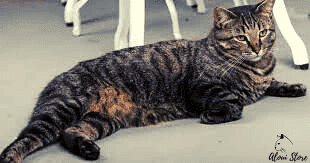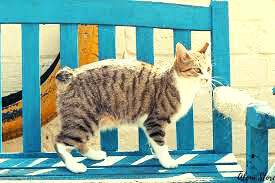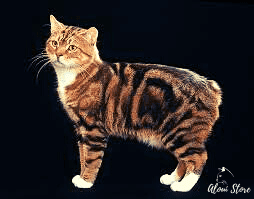Manx cat breed
The Manx cat has a distinctive shape that makes everyone who sees it stop in front of it.
It has a tail as if it were cut, so everyone who sees it stands in a state of amazement and astonishment, and it has long been a desirable cat because of its hunting skills, and it is considered one of the social, pet, and active cats.
See all of the Manx features below!
 |
| Manx cat breed |
Read more: Scottish Fold Cat
1-History
2-Size
3-Personality
4-Health
5-Feeding for Manx cats
1-History
Is it really a cat if it doesn't have a tail!?
The Manx cat grew up on the Isle of Man, off the coast of Britain.
There are plenty of cats with short tails or no tails, but the Manx and his sister, "the Simeric Longhair Cat", are the only ones who have been specially bred to be without tails.
Sometimes jokingly said to be the offspring of a rabbit, the Manx cat is the result of a genetic mutation that was then condensed by the remote cat site on the Isle of Man, off the coast of Britain.
The cats are thought to date back to the year 1750 or later, but whether a no-tailed cat was born there or arrived on a ship and then spread its genes throughout the island's population is unknown.
The Manx cat was one of the original show cats, and was present at the first cat shows held in Great Britain. The Manx cat has been introduced as a breed name - and with the modern pronunciation of the name, “Manx cat” since the late nineteenth century, the first known breed was published in 1903.
If we look at the Manx cat scientifically, the scientists went that the shortness or lack of the tail in these cats is caused by automatic change, so all cats when breeding produce from time to time some cats without a tail, but in the Manx cat, in particular, it was due to its isolation from breeding with other cats abroad.
It was said that it came on ships without a tail, so it is difficult to go back to the origin of the Manx cat ... You confused us, Manx cat, as everyone thinks and tries to analyze to reach your origin and where your tail went.
2-Size
This is a medium-sized cat that weighs 8 to 12 pounds and feels surprisingly heavy when raised. Manx ripens slowly and may not reach full size until it's five years old.
- Height: 25 to 37.5 cm
- Fur: The Manx cat has two types of short or long fur, soft, dense, and soft. The outer layer is rough, and the overall appearance of the coat is short
- Colors: white, blue, black, red, cream, silver, tortoiseshell, cream blue, brown
- Life expectancy: 9 to 13 years
 |
| Manx cat breed |
3-Personality
The Manx cat retains its wonderful hunting skills and alert nature. With men around the house, you don't need a guard dog; You have a "watched cat" that reacts quickly and will make a threatening sound or may attack you when you see something out of the ordinary. If he sees that you are not upset, he will settle down again.
When he's not protecting his family and possessions from mice, stray dogs, or other threats, the Manx is a gentle, mild-tempered, and affectionate companion who enjoys calm surroundings.
This does not mean that it is inactive. This is a happy, playful cat who loves to follow his favorite person through the house and help with everything he does. When you are ready to relax, your Manx will be on your lap, ready for a relaxing nap.
If there is no cuddle available, he will turn around at the closest available location that will be allowed to monitor you. He "speaks" in a calm voice and will continue the conversation if you talk to him.
The Manx cat is a very playful cat with extremely strong hind legs. Where they can jump very high and possess many dog-like characteristics, from recovering objects to burying their toys. Manx cats are often found on tables or shelves. This breed is easygoing and cheerful in a family that has time to interact and play with.
The Manx cat comes in two types of long and short hair, which have double coats that should be thick and plush. Short hair has a fairly solid and lustrous outer layer, and long hair has a silky, medium-length coat.
This is a smart cat that can learn tricks, including fetch and come, and is willing to walk on a leash if taught early. He often loves to ride in a car, which makes him a great companion on long trips.
It's not unusual for the Manx to enjoy playing in the water - he is an island cat, after all - and you may find him turning on faucets or "fishing" in the fountain.
Read more: Norwegian Forest cat
4-Health
Both purebred cats and mixed cats have varying states of health problems that may be hereditary in nature. The Manx is generally healthy, but the following diseases have been observed in the breed:
Arthritis of the tailbone in cats with partial tails
Problems with a particularly short spine, which may fail to provide adequate nerve and muscle endings. This genetic trait in some very short Manx cats can lead to an opening in the spine, lack of bowel or bladder control, and either the hind legs being weak or one hind leg being weak.
The condition affects approximately 20 percent of Manx cats, and it is often gray and usually appears by the time a kitten is 4 months old, which is a good reason to wait until this age before bringing a Manx kitten home.
 |
| Manx cat breed |
5-Feeding for Manx cats
Like most cats, the Manx cat requires a balanced diet of protein, vitamins, minerals, fats, and water. Cat food should also include omega-3 fish oils to keep them healthy, while ingredients like taurine are essential for their eyesight and heart and fiber for their digestion and control of their weight.
Manx cats also feed commercially prepared wet or dry cat food, be sure to look for foods that contain meat as a primary ingredient.
When serving wet food, you may need to warm up, as Manx cats do not like refrigerated meals. You can also mix wet food with dry food to enhance the flavor.
Experts advise against giving Manx cats drink cow's milk, as lactose can build up in the intestines and cause digestive problems.
As is the case with "human" foods like tuna, offering a pet milk substitute is a temporary fix.
And if you like the content, please share it with friends so that the benefit prevails. You have all my love and appreciation, and do not forget to subscribe to the blog to receive everything new so that you will be the first to benefit.
See you with another breed.